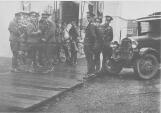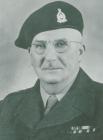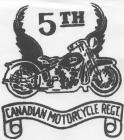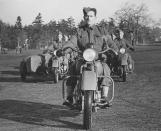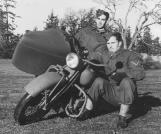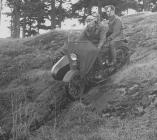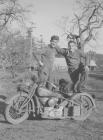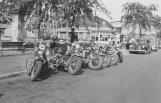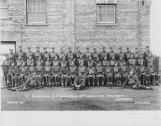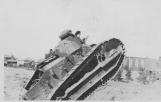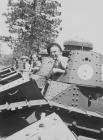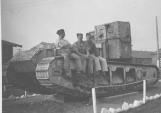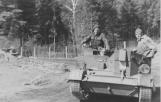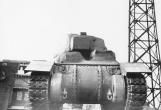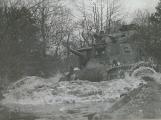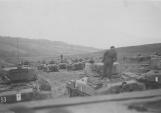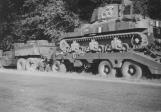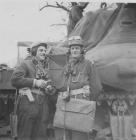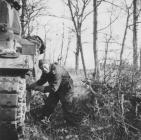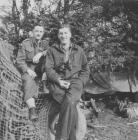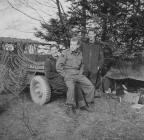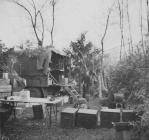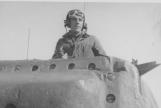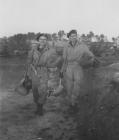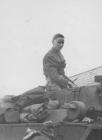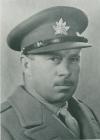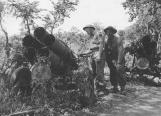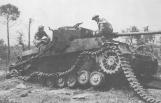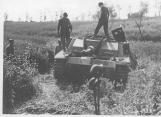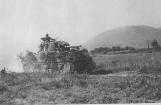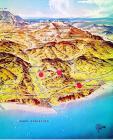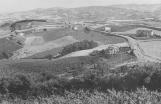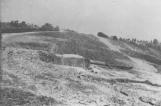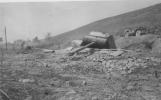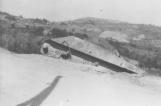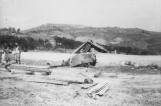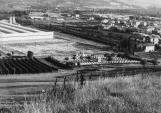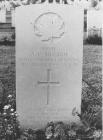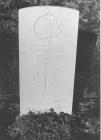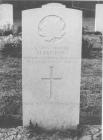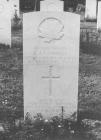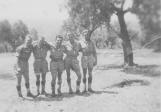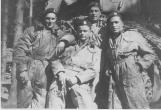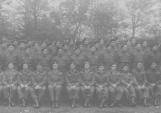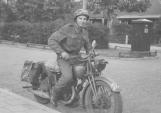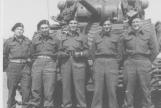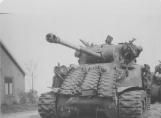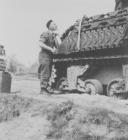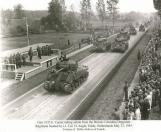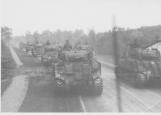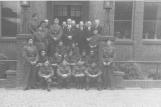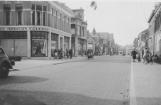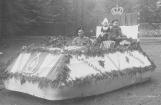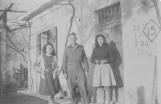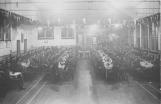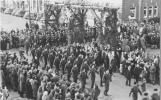

Okanagan Military Museum
Kelowna, British Columbia
1
04) 9th Armoured in WW II 1939 - 1945- Declaration
- Prince George Detachment
- 5th Canadian Motorcycle Corps
- 9th Canadian Armoured Regiment (BC Dragoons) CASF
- England
- BCDs go to Italy
- Hitler Line
- Gothic Line
- Northwest Europe
- Victory and Repatriation
3
The Regiment spent the winter of 1939-1940 training, and waiting for orders to mobilize. Proof that the nation was truly at war was brought home in late 1939 when elements of the Regiment under Capt. Harry H. Angle were detailed to guard rail lines and bridges in the Prince George area against sabotage.The annual camp at Vernon in May 1940 saw the Regiment train for the first time without horses. The successes of Hitler's armour in Poland, and more recently in Western Europe, finally put an end to the view that men on horseback could fight effectively against tanks and machine guns. Of course, the Regiment had no tanks or armoured cars with which to train; but they made do with trucks and cars rented from local garages, which were used to simulate armoured vehicles, while saw-horses doubled for motorcycles.
As spring of 1940 advanced into summer, many of the men left to join other units, such as the Seaforth Highlanders of Canada or the British Columbia Regiment, in the hope of going overseas quicker. For those who remained, the waiting ended in July 1940 when word was received that a new regiment would be organized and mobilized out of the militia unit, to be called the 5th Canadian Motorcycle Regiment (BCD). As with the 30th BCH and the 2nd CMRs in WW I, a new active service force was to be created in addition to the existing militia unit, from which many recruits would be drawn. The new regiment would have an establishment of 450 all ranks, with a Headquarters, and three fighting squadrons. The militia unit, the BC Dragoons, would continue in the Okanagan as an armoured car regiment.
The 5th Canadian Motorcycle Regiment (5th CMC) immediately concentrated in Vernon. Enthusiasm was high, but again there was no equipment for training. Much of the early fall of 1940 was spent rendering the men physically fit.
In October 1940 the Regiment was sent to southern Vancouver Island, one squadron (Sqn) to Duncan, the balance to Esquimalt. During the winter of 1940-1941, the Regiment received its motorcycles and the men became quite proficient in their use on the Island roads and countryside, to the occasional terror of the local population.
16
No sooner had the Regiment begun to feel comfortable in the role with the motorcycles than orders were received in February 1941 that the unit was again to be converted, this time into a tank regiment. The new name was to be the 9th Canadian Armoured Regiment (BCD) with its strength increased to 583 all ranks. It was under this designation that the unit fought as armour throughout the balance of the war, as part of the 5th Canadian Armoured Division (5thCAD) or the "Mighty Maroon Machine" as it came to be known, owing to the colour of the divisional badge.In May 1941 the motorcycles were turned in and the Dragoons boarded train for Camp Borden in southern Ontario. There they received their first armour training at the Canadian Armoured Fighting Vehicles Training Centre established by Major Frank F. Worthington in 1939. He is considered the founder of the Canadian Armoured Corps.
When the active unit changed to tanks, the militia unit was renamed the 9th (Reserve) Armoured Regiment (BCD), with an authorized establishment of 32 officers and 548 other ranks. During the war and average of 250-350 men actually served at any one time, with approximately 200 going to the annual summer camps. Those in the reserve unit were primarily men whose jobs at home were deemed essential to the war effort, and those who did not satisfy the age or fitness requirements of active service. Squadrons remained in Vernon, Kelowna and Penticton. They served as a reminder to the local population of the unit overseas, and as a link to the active force men. In this they were supported by the BCD Women's Auxiliary. Formed in 1940 while the active force unit was training with motorcycles on Vancouver Island, it was primarily an organization of the families of the men in the Regiment. Throughout the war and especially after the unit went overseas, the Auxiliary performed admirably in raising morale by regularly sending cigarettes, Reader's Digest magazines, hand-knitted socks and scarves, and Christmas packages, as well as money for parties and 'smokers.' Most of the funds supporting these activities were raised at dances, through the sale of raffle tickets, on
'tag days' and by donations.
For the active force unit at Camp Borden, the main problem during the summer of 1941 was again the lack of equipment. The only tanks available were American made WW I French designed antiques, which continually broke down. This was not surprising as, at the outbreak of war, Canada had but 14 tanks in the entire country, and with no facilities to manufacture them. Much training, therefore, took place on the "RYPA" or Roll, Yaw, Pitch, Alternate Apparatus, which simulated the operation of a tank turret and gun. Interspersed with the practical training was course work in the construction and maintenance of tanks. Nearly half the personnel would need to be tradesmen, skilled in keeping the tanks in the fighting echelon in proper working order. Some of the familiarization and training was done at the actual manufacturing plants in the US and Canada.
23
Some of the Okanagan boys enjoy the sunshine of Camp Borden during the summer training in 1941.1941
Camp Borden, Ontario, Canada

24
After six months in Camp Borden the Regiment sailed overseas, arriving in Liverpool, England in November 1941. For the next two years the Regiment was to remain in England, training primarily on the plains in the southern part of the country. Continuous blackouts and the removal of road signs made it difficult for find one's way around at night. While on leave the troops were required to carry their helmets, gas masks and weapons everywhere, in case the German actually invaded the British Isles. Gasoline and food were strictly rationed. Mail delivery was free, but censored.Without tanks during its first months in Britain, training for the Regiment consisted of route marches, rifle range and grenade throwing practise, map reading and the like. As at Camp Borden, a number of men were assigned to schools elsewhere for courses in subjects like gunnery, wireless communications, and driving and maintenance. As the winter of 1941-1942 wore on, morale declined. In fact, there was talk that the Regiment might be broken up for reinforcements for other units. On one wished this: so a short time and much hard work later, when King George VI and Queen Elizabeth inspected the Regiment in April 1942, the performance was flawless.
Lt. Col. W. C. Murphy was appointed commanding officer in May 1942. Murphy was a Vancouver lawyer, physically fit, and an amateur boxer, but with no training in tanks. Nevertheless, for the better part of the next year, until he left in March 1943, "Spud," as he was known, drove himself and the men hard in sports and training, correcting morale and training problems. He moulded the Regiment into a fighting unit by example, and by his rigorous standards of training and discipline. The improvement coincided with the delivery of tanks in the spring and summer of 1942. The first tanks were American built General Lee M-3 and the General Stuart M-2A4, but later most were the Canadian built Ram I and Ram II.
In January 1943, the Canadian Armoured Divisions were reorganized to the standard British model, being on armoured brigade, one infantry brigade, and one artillery group. The BCDs joined the Lord Strathcona's Horse (RC), the 8th Princess Louise's (New Brunswick) Hussars, and the Governor General Horse Guards to form the 5th Canadian Armoured Brigade (5th CAB) within the 5th Canadian Armoured Division (5th CAD). The infantry elements of the 5th CAD were the Perth Regiment, the Cape Breton Highlanders, and the Irish Regiment of Canada. The 17th Field Regiment, the 8th Field Regiment (SP), the 4th Anti-tank Regiment and the 5th Light Anti-Aircraft Regiment of the Royal Canadian Artillery Corps, were the Divisional artillery components.
The reorganization required an increase in strength for the Dragoons, which by May 1943 was settled at 37 officers and 727 other ranks. There would now be 5 troops (of 3 tanks), instead of four per squadron. By this time the Regiment had received 67 tanks, 10 'Bren' or universal carriers, 9 scout cars and 80 other trucks, jeeps and motorcycles.
51
In May Lt. Col. Murphy went off to become the Chief of Staff for the Division and later given command of the 1st Canadian Armoured Brigade from February 1944 to wars end. He was replaced each time by an old lime BCD, Lt. Col. H. H. Angle, who was a Militia Capt. before the war.Throughout 1943 the Regiment engaged in exercises on the Brigade level, simulating movements in battle, and ironing our supply and communication problems critical to the efficiency of the unit. Then, in November, following mass inoculations for typhus and malaria, and the issuing of mosquito nets and other tropical kit, the Division was dispatched to the Italian theatre to become part of General Montgomery's famous "Desert Rats," the 8th Army.
In late November the advance parties of the Regiment disembarked in Naples. Owing to difficulties with transport the remainder detoured to North Africa and a camp near Algiers where the men visited the Casbah and other sites of interest until regrouping in Italy in December. They had left their well-maintained vehicles and tanks in England. In Italy they received the cast-off, battle worn and damaged relics of the 8th Army. In their usual good spirits and manner all ranks dealt with the problem in a proper military fashion. When asked to provide vehicles to other units the Regiment passed along the best they had.
During the early months of 1944 the Dragoons trained behind the lines in southern Italy practising tactical manoeuvres with the infantry units in the Division. The next several months saw them stationed in the town of Matera, near Naples, where it was re-equipped with newer vehicles and the new American built Sherman M4A4 tanks. They weighed 35 tons each and were powered by a Chrysler 30 cylinder, multi-bank engine for a maximum speed of 25 mph and a range of 100 miles. Armament consisted of a 75mm main gun, a .50 Calibre Browning Heavy Machine gun, and two .30 Calibre Browning Machine Guns. The Sherman had a five-man crew: Crew commander, Gunner, Loader/Wireless Operator, Driver and Co-driver/hull machine-gunner. Experience was to show that the tanks armour was too thin; many crews welded steel track segments onto the front and sides.
In February 1944 a new war establishment was authorized for the Regiment, which meant a reduction in manpower of 70 all ranks. There would once again be four troops per squadron instead of five. A new wrinkle would be the addition of a 44-man Reconnaissance troop mounted in 11 "Honey" tanks. These were Stuart tanks with the turret and main gun replaced by a heavy machine gun and retaining the hull-mounted light machine gun. These 'recce' tanks would prove very useful in battle.
55
In May 1944, (a month before the D-Day landings in Normandy) the Regiment was committed to battle for the first time, along with the rest of the 5th CAD and 1 Canadian Corps. They were to clear a path to Rome. First the 1st Canadian Infantry Division (1st CID) fought through the "Hitler Line" in the Liri Valley south of Rome. Then, the 5th CAD fought through the improvised German defences and reserve formations at the battle of the Melfa River crossing. The Regiment led the Division and was under the command of Lt. Col. F. A. Vokes, a graduate of the Royal Military College, a former Lord Strathcona officer and an aggressive, even impatient man. Major David Kinloch's 'B' Squadron encountered and knocked out the first Panther tanks in Italy, (Lt. Nigel Taylor's tank got the first), the German commander's special reserve. The Strathcona's were to cross the Melfa, but lost 17 tanks in hard fighting and stalled. Vokes sent 'C' Squadron to their aid. They crossed and secured the bridgehead at the cost of two troops. In the close and difficult country the Honey recce tanks performed well. Breaching the German defence forced them to abandoned Rome.This was the start of the Regiment's trek north up the west coast and then cross over to the east coast to go further north for a total of 500 miles, not counting tortuous and winding roads or battle distances.
On 31 August 1944, the Regiment was heavily engaged in breaking the "Gothic Line." Major-General Bert Hoffmeister, a Seaforth Highlander of Canada militiaman from Vancouver, commanded the 5th CAD. He was a bold, aggressive and charismatic commander who did not wait to give the Germans time to react. He decided to attack the Gothic Line as soon as possible and he gave the lead to the Dragoons. Lt. Col. Vokes decided not to wait for infantry support and attacked without it. During the twelve hours of continuous battle the Dragoons lost 32 of the 50 tanks that entered the battle, and over 50 officers and men killed or wounded, including Vokes, who was mortally wounded in the advance. The Regiment took and held its objectives thereby cracking the Gothic Line, forcing the Germans to withdraw as other units and formations broadened the crack.
The battered but proud regiment was taken over that evening by former commander, Lt. Col. Harry Angle; sent by Maj-Gen. Hoffmeister from his position as chief of staff at 5th CAD headquarters. Angle stayed on as Commanding Officer (CO) for the rest of the war. The losses were serious; indeed, veterans of the battle called the route of advance "Death Valley." The Germans had cleared a large area of brush and other cover to provide an unobstructed field of fire for their heavily fortified, anti-tank guns. The battle brought recognition to the 5th CAD from the 8th Army's commander, General Oliver Leese. He told General Montgomery, who was then in Normandy, "The troops fought well, especially the 5th CAD. This Division led by Bert Hoffmeister, has the terrific dash of the 7th Armoured (Desert Rats Division) in the old days. They have done extremely well."
Over the years the historians have reviewed the battle to the Regiment's favour. Some historians, such as Dr. Wm McAndrews, think that Lt. Col. Vokes should have received the Victoria Cross for having the moral courage to violate tactical doctrine and attack without close infantry support. One of the severest critics of the Canadian Army's training and operations, John English, wrote that the operation on the Gothic Line "may have been the finest by any Canadian formation in the Second World War."
Next, the Dragoons endured the heavy shelling and mortaring in the fighting around Coriano Ridge in September 1944. Later in the fall, they advanced through Rimina and Ravenna and over to the Lamone River, and into the flat, wet Romagna country of northern Italy, ending the fighting near the Bay of Commachio. As Lt. Col. Angle noted in his diary on January 6, 1945: "That's that. We did it again. We have put flank of Eighth Army on the Adriatic and along southern end of Lake Commachio. The General is delighted - and so should be - these men are superb. Thank God, casualties light. I am going to sleep for a week."
79
The 8th Army objective had been Venice but it was stopped because the troops were needed in northern Europe. In February 1945, the 1st Canadian Corps, including the BCDs, were withdrawn from Italy and sent to join the 1st Canadian Army fighting under the command of Field Marshal Montgomery in Northwest Europe. They crossed back to the west coast of Italy to sail to Marseilles, France, and then by train to the town of Roulers, in Belgium. There they were re-equipped prior to moving into the Netherlands to join the final push against the Germans.In April 1945 the Regiment was once again in action, this time as part of the armoured force that drove from Arnhem to the Ijsselmeer, cutting the German forces in Holland in two. The Dragoons found themselves fighting old men and boys as well as battle-hardened veterans of the German Army. Immediately thereafter the Regiment shifted to the eastern Netherlands to help clear the Delfzijl pocket of enemy in late April 1945. This was the last battle fought by the Regiment in WW II. It saw troops from the Dragoons liberate the towns of Appingdam and Marsum and shoot from atop the dikes at the fleeing German troops escaping by water to Emden, Germany.
VE-Day, 5 May 1945, found the Dragoons billeted in Groningen, Holland amid wild celebrations. "Thank God so many of us still live," wrote Lt. Col. Angle. "Celebrations in Groningen consisted of much shouting and shooting of SA (small arms) and flares," he continued. "Most of the shooting is done by civilians. The troops received the news in their usual matter-of-fact manner and carried on with their jobs." The Burgomaster of Loppersum was not so matter-of-fact. On 15 May 1945 he wrote to Lt. Col. Angle in this way:
"My Dear Commander, The Netherlands are Free. This is a wonder which we can scarcely conceive. To be free from oppression, and tyranny, from danger and terror. Next to God, we owe your brave officers and soldiers thanks beyond words. Loppersum pays tribute to you in this moment. We will never forget your glorious achievements. Long live Canada. Long live its brave army."
During the fighting the unit suffered 289 casualties, 4 officers and 78 other ranks killed, 27 officers and 180 other ranks wounded. One officer and one soldier were captured; the officer escaped. The Regiment was awarded the following battle honours: Liri Valley, Melfa Crossing, Gothic Line, Pozzo Alto Ridge, Lamone Crossing, Conventello - Commachio, Italy 1944-1945, Ijsselmeer, Delfzijl Pocket, and Northwest Europe 1945. Members of the Regiment received 20 decorations by wars end.
Following VE-Day the Regiment spent seven months in Holland before returning home. There was much recreation, sports, and leave to Amsterdam, Rotterdam and Utrecht. The unit's tanks were spruced up with new paint for an inspection and mounted march-pas of the 5th CAD on 25 May before Lt. Gen. H. Crerar, at the Eede airport near Groningen. At the end of May the Regiment moved to the town of Veendam to assist in guarding and moving German prisoners of war, marching their way back home. Of this Lt. Col. Angle remarked, "The Germans marched past (sic) by the thousands. Their MT (motor transport) and horse-drawn transport is falling apart and will not last farther than then the German border, methinks. . . There were no incidents. Their troops and ours adopted a 'stony' reserve towards each other - which is as it should be."
By July 1945 the Regiment had turned over all its tanks, "those fearsome and faithful chariots," in the words of Angle, to the Ordnance Corps. Gradually, throughout that summer, men left the Regiment to volunteer for occupation duties in Germany, for Far Eastern service against Japan, or repatriation back to Canada.
103
Later in the summer the Dragoons were ordered to supply a squadron to establish a camp in Pilsen, Czechoslovakia, as a distribution point for vehicles the Canadian Government had agreed to provide to Poland and Czechoslovakia in cooperation with the United Nations Relief and Rehabilitation Association. The camp lasted until October 1945 when the squadron returned to Veendam following a warm farewell from the local Czech populace.Finally, in December 1945 the Dragoons left Holland for England, and then by ship for Canada. The Regiment arrived by train in Kelowna in January 1946. In Battledress uniforms, the men detrained and marched through the city past cheering crowds, to the Scout Hall. There the Regiment was officially welcomed home and thanked by the Mayor and Council of the City for their five years of service to their country. Their achievements in Europe were honoured by a granting of the "Freeman of the City of Kelowna" to Lt. Col. Harry Angle.
